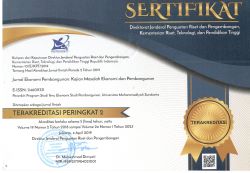EFEKTIVITAS DISTRIBUSI RASKIN DI PEDESAAN DAN PERKOTAAN INDONESIA
Jamhari Jamhari(1*)(1) Jurusan Sosial Ekonomi Pertanian Fakultas Pertanian Universitas Gadjah Mada Jalan Flora Bulaksumur Yogyakarta 55281 Telepon/Faks. 0274-516656
(*) Corresponding Author
Abstract
This research aims to investigate effectiveness of rice for the poor program (Raskin) in rural and urban Indonesia based on the National Socio Economic Survey data (Susenas) collected by Central Bureau of Statistic (BPS) in 2007. Number of sample was 52,370 households. Effectiveness of Raskin Program was measured by target, quantity and price accuracy indexes. Logistic regression model was used to identify factors affecting probability of a household to receive raskin or not. The results of analysis show that raskin distribution was not yet accurately reach the target beneficiaries. Raskin distribution was also not accurate in quantity and price. Quantity accuracy index was 58 percent in rural, 53 percent in urban and 57 percent in Indonesia. Price quantity index was 68 percent in rural, 63 percent in urban and 67 percent in Indonesia. Probability of a household to receive raskin was affected by education, gender, age, household member, income, employment, floor condition and location.
Keywords
raskin distribution; accuracy index; poor households; rural
Full Text:
PDFArticle Metrics
Abstract view(s): 942 time(s)PDF: 1069 time(s)
Refbacks
- There are currently no refbacks.
















